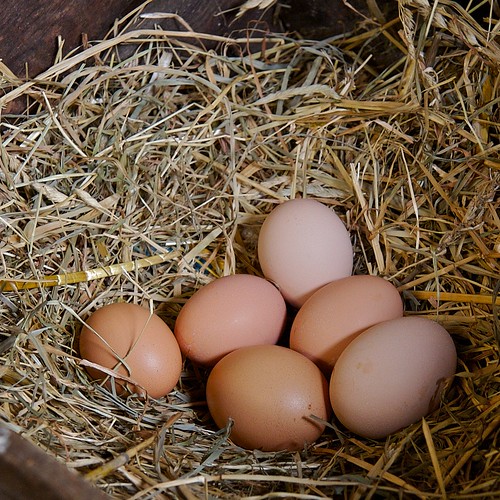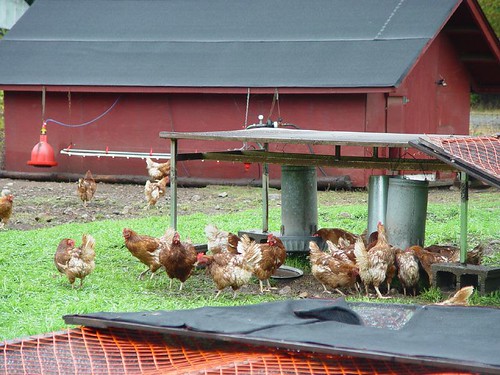Cropedia:Eggs
Eggs
" "
"
UBC Farm Eggs
Eggs are one of the most popular products sold at the UBC Farm Market and are one of its top revenue generators. They are also distributed to a number of restaurants and cafeterias around campus, including Agora and Sage Bistro; and as an ingredient can be most commonly found in Agora's Quiche of the Day. Hens usually lay 1 egg every 1-2 days. The UBC Farm chickens are fed organic vegetarian feed and follow COABC Standards and Practices . The flock is rotated every two years to maintain laying vigour.
Seasonality
Spring through Fall as available.
Nutritional Information
Eggs contain all the essential protein, minerals and vitamins, except Vitamin C. But egg yolks are one of few foods that naturally contain Vitamin D. Eggs also contain choline, which is necessary for healthy cell membranes in the body. Choline stimulates brain development and function and helps preserving memory. Eggs also are good for your eyes because they contain lutein which helps prevents age-related cataracts and muscular degeneration. In fact, eggs contain more lutein than spinach and other green vegetables.
| Nutrition Facts/Valeur Nutritive | |
|---|---|
| Serving Size: 50 g | |
| Amount Per Serving | %Daily Value* |
| Calories 77 (Calories from Fat 48) | |
| Total Fat 5g | 8% |
| Saturated Fat 2g | 8% |
| Trans Fat 0g | |
| Cholesterol 212mg | 71% |
| Sodium 62mg | 3% |
| Total Carbohydrate 1g | 0% |
| Dietary Fiber 0g | 0% |
| Sugars 1g | |
| Protein 6g | |
| Vitamine A | 6% |
| Vitamine C | 0% |
| Calcium | 2% |
| Iron | 3% |
| * % Daily value based on a 2000 calorie diet | |
[Source]
Recipes
Agora Café- Seasonal Quiche
Savoury Quiche Dough Yield: Two 9-inch pie crusts Ingredients:
1 ½ cups spelt flour
1 ½ cups brown rice flour
2 cups whole wheat flour
2 tsp salt
1 tbsp dried rosemary
1 cup cold cubed butter
½ cup cold water (more if necessary)
2 eggs
Baking weights or grain
Directions:
1) Preheat oven to 350° F.
2) Mix dry ingredients in a bowl.
3) Cut butter into flour until mixture resembles coarse breadcrumbs.
4) Lightly whisk the eggs and add eggs and water to the butter and flour mixture. Mix gently with a fork until dough begins to hold together. Add more water if necessary- be careful to not add too much. The dough should still be slightly crumbly with some dry parts.
5) Divide dough in two parts. If you are not making two quiches now, tightly wrap one half of the dough in plastic wrap and freeze for up to two weeks for use at a later date.
6) With the other half of the dough, press dough evenly into pie tin covering the bottom and sides evenly. Prick dough with a fork or knife to allow steam to escape.
7) Line inside of dough with parchment paper and top with baking weights.
8) Bake for 12 minutes, or until it just starts to brown. Once the shell is slightly brown remove from the oven. Remove the baking weights and parchment paper.
9) Meanwhile, prepare quiche filling.
Seasonal Vegetable Filling
Yield: For one quiche
1 Tbsp. olive oil
1 c. onion, shallot, or leek, diced
4 cloves garlic, crushed or minced
1 c. cooked seasonal veggies (in the winter use one or more of steamed kale or chard, sautéed mushrooms, baked butternut squash; in the summer, use steamed or sautéed broccoli, cauliflower, sautéed peppers, summer squash, etc.)
8 eggs
¾ c. milk
~¼ tsp. salt in eggs
¼ tsp cracked black pepper
½ c. domestic cheese (cheddar-shredded, goat-crumbled or other)
Directions:
1. Preheat oven to 350F.
2. Heat olive oil in fry pan on medium. Add the onions and garlic and cook until beginning to brown. Add vegetables and cook until cooked through.
3. Meanwhile crack eggs into a bowl. Add salt, pepper and milk. Whisk together until well combined.
4. Place cooked vegetables in precooked quiche shell. Pour egg mixture over.
5. Sprinkle cheese on top.
6. Place quiche in oven and bake about 45 minutes or until egg has set and the cheese has begun to brown.
Additional usage inventory
- In the Garden:
Got Slugs? Crush leftover eggshells and sprinkle over the soil. The shells' sharp edges scrape the soft bellies of outdoor pests like snails and slugs, preventing them from snacking on the plants' leaves. As a bonus benefit, the shells add calcium to the soil, which plants use to build the new cell walls and membranes required for growth.
Academic connections
The chickens on the UBC Farm are a cross-breed of Barred Plymouth Rocks and Rhode Island Reds, which were specially developed for UBC Farm at UBC's Avian Research Centre in Agassiz. They hope to improve the cold tolerance and free-range strength of these chickens.
" "
"
References
Images:
- Egg picture: http://www.flickr.com/photos/69675357@N00/1095956138/
- Nutritional Value: http://www.nutritiondata.com/facts/dairy-and-egg-products/117/2
[1] Rosy Smit, Former UBC Market Garden Coordinator 2000-2003
[2] Egg Quality/Egg Washing. Robert Plamondon’s Poultry Pages. Retrieved March 26th 2010. http://www.plamondon.com/faq_eggwashing.html
Additional notes
Washing:
To wash, the dirty eggs are placed in a basket (maybe 30 at a time), then submerged into a bucket that is filled with warm water and a special detergent. The bucket has a tube going into the bottom of it where air is pumped so the eggs tumble around gently with the bubbles coming up from the bottom. They then are taken out and left to dry then packaged in egg cartons [1].
The basic issue is that dirty eggs are covered with bacteria, which have trouble getting through the shell so long as it's dry. As soon as the shell is wet, the bacteria pass through the shell more easily. Also, if you cool the egg, the contents shrink a little, causing a partial vacuum inside that tends to suck foreign matter into the egg. The upshot is that you should always wash eggs in water that's warmer than the egg is, and you should sanitize the eggshells to kill any bacteria on the shell [2].
Did You Know?
That you can check to see if an egg went bad by placing it in a glass of water? If it sinks, it’s still good; if it floats it has gone bad.